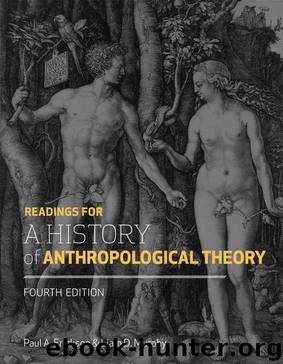Readings for a History of Anthropological Theory, Fourth Edition by Paul A. Erickson & Liam D. Murphy

Author:Paul A. Erickson & Liam D. Murphy [Erickson, Paul A. & Murphy, Liam D.]
Language: eng
Format: epub
ISBN: 9781442606562
Amazon: 1442606568
Publisher: University of Toronto Press, Higher Education Division
Published: 2013-04-21T07:00:00+00:00
VII
Which brings us, finally, to theory. The besetting sin of interpretive approaches to anything—literature, dreams, symptoms, culture—is that they tend to resist, or to be permitted to resist, conceptual articulation and thus to escape systematic modes of assessment. You either grasp an interpretation or do not, see the point of it or you do not, accept it or you do not. Imprisoned in the immediacy of its own detail, it is presented as self-validating, or, worse, as validated by the supposedly developed sensitivities of the person who presents it; any attempt to cast what it says in terms other than its own is regarded as a travesty—as the anthropologist’s severest term of moral abuse, ethnocentric.
For a field of study which, however timidly (although I, myself, am not timid about the matter at all), asserts itself to be a science, this just will not do. There is no reason why the conceptual structure of a cultural interpretation should be any less formulable, and thus less susceptible to explicit canons of appraisal, than that of, say, a biological observation of a physics experiment—no reason except that the terms in which such formulations can be cast are, if not wholly nonexistent, very nearly so. We are reduced to insinuating theories because we lack the power to state them.
At the same time, it must be admitted that there are a number of characteristics of cultural interpretation which make the theoretical development of it more than usually difficult. The first is the need for theory to stay rather closer to the ground than tends to be the case in sciences more able to give themselves over to imaginative abstraction. Only short flights of ratiocination tend to be effective in anthropology; longer ones tend to drift off into logical dreams, academic bemusements with formal symmetry. The whole point of a semiotic approach to culture is, as I have said, to aid us in gaining access to the conceptual world in which our subjects live so that we can, in some extended sense of the term, converse with them. The tension between the pull of this need to penetrate an unfamiliar universe of symbolic action and the requirements of technical advance in the theory of culture, between the need to grasp and the need to analyze, is, as a result, both necessarily great and essentially irremovable. Indeed, the further theoretical development goes, the deeper the tension gets. This is the first condition for cultural theory: it is not its own master. As it is unseverable from the immediacies thick description presents, its freedom to shape itself in terms of its internal logic is rather limited. What generality it contrives to achieve grows out of the delicacy of its own distinctions, not the sweep of its abstractions.
And from this follows a peculiarity in the way, as a simple matter of empirical fact, our knowledge of culture . . . cultures . . . a culture . . . grows: in spurts. Rather than following a rising curve of
Download
This site does not store any files on its server. We only index and link to content provided by other sites. Please contact the content providers to delete copyright contents if any and email us, we'll remove relevant links or contents immediately.
Born to Run: by Christopher McDougall(7065)
The Leavers by Lisa Ko(6912)
iGen by Jean M. Twenge(5366)
Sapiens by Yuval Noah Harari(5294)
The Kite Runner by Khaled Hosseini(5085)
Spare by Prince Harry The Duke of Sussex(5074)
Machine Learning at Scale with H2O by Gregory Keys | David Whiting(4186)
Bullshit Jobs by David Graeber(4097)
Never by Ken Follett(3795)
Goodbye Paradise(3728)
Livewired by David Eagleman(3685)
Fairy Tale by Stephen King(3220)
A Dictionary of Sociology by Unknown(3031)
Harry Potter 4 - Harry Potter and The Goblet of Fire by J.K.Rowling(2990)
The Social Psychology of Inequality by Unknown(2941)
The Club by A.L. Brooks(2862)
Will by Will Smith(2794)
0041152001443424520 .pdf by Unknown(2784)
People of the Earth: An Introduction to World Prehistory by Dr. Brian Fagan & Nadia Durrani(2702)
